
|
Zelig (1983)
Woody Allen's mock documentary demonstrated the technical accomplishment of laboriously
matching and interweaving authentic and older period film (newsreels and documentary
footage) from the 1920s and 30s with newer, flickering B/W film shot by Oscar-nominated
cinematographer Gordon Willis, to make the film appear authentically 'historic'.
[Note: These same effects would be replicated 10
years later in Forrest Gump (1994).]
In addition, the Narrator's (Patrick Horgan) authentic
BBC documentary-style narration, as well as the commentary (by radio
or through interviews) of Zelig's friends, relatives, and associates,
including literary personages, such as Susan Sontag, added to the
film's believability. There were also movie reenactments of events
in Leonard Zelig's life, including the biopic The Changing Man
(1935), by Warner Bros.
Chameleon-like Leonard Zelig (Woody Allen) in the Jazz
Era of the 1920s (and extending into the 1930s) became known as an
individual who appeared to take on the characteristics of those he
associated with - known as "the Zelig phenomenon":
- Zelig awaited his turn at bat as "Lou Zelig" with
baseball player Babe Ruth
- he was seen a South Side of Chicago speakeasy gangster
("a tough-looking hombre")
- he appeared as a "colored boy" playing
trumpet in the band
- Zelig was seen in a photograph with Eugene O'Neill,
and in a second photo portraying Pagliacci
- he became a "strange looking Oriental" in
a Chinese establishment in NYC's Chinatown; but after engaging
in a fight and being transported to a hospital in a strait-jacket,
he emerged 20 minutes later as a "Caucasian," and claimed
he was a learned doctor or psychiatrist who "studied and worked
with Freud in Vienna"
- Zelig was also identified as "the son of a
Yiddish actor named Morris Zelig" who grew up "frequently
bullied by anti-Semites,"
but adjusted well even though an alcoholic
- various diagnoses were offered as reasons for the
transformations: it was all "glandular in nature," or "due
to secretions,"
or "picked up from eating Mexican food," or "neurological
in origin,"
or was some kind of "psychological" disorder resulting
from an unstable makeup that accounted for "his metamorphoses";
further notions included
"poor alignment of the vertebrae," but nothing was conclusive
regarding the nature of his "astonishing manifestation"
- to demonstrate his remarkable personality changes,
Zelig became obese next to two overweight men, and turned black
in the presence of two Negro men
- some Americans reacted with envy: "I wish I
could be Lenny Zelig, the changing man. I'd be different people.
Someday my wishes will come true"
- finally, Dr. Eudora Fletcher (Mia Farrow) at the
Manhattan Hospital placed Zelig under hypnosis and made a definitive
diagnosis about his need for approval: (Narrator: "Dr. Fletcher
describes Zelig as a human chameleon. Like the lizard that is endowed
by nature with a marvelous protective device that enables it to
change color and blend in with its immediate surrounding, Zelig,
too protects himself by becoming whoever he is around"); apparently
out of his desire to fit in and be liked, Zelig unwittingly took
on the characteristics of strong personalities around him, although
some felt Zelig had a "unique mental disorder"
|
"The Zelig Phenomenon"
|
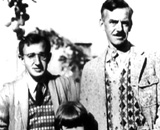
With Eugene O'Neill
|
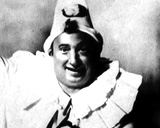
As Pagilacci
|
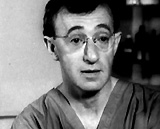
As a Psychiatrist
|

As a Young Jewish Male
|

"Adjusted to Life"
|
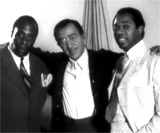
Zelig as a Chameleon with Two Negro Men
|
- the Narrator stated: "To the Ku Klux Klan,
Zelig a Jew who was able to transform himself into a Negro or lndian,
was a triple threat"
- Zelig was treated by Dr. Fletcher, who studied his
answers to her question: "You recall the first time you began
behaving like the people you were around?"; other doctors
insisted on treatment with an experimental drug known as somadril
hydrate, causing Zelig to undergo severe mood changes
- shortly later, Zelig was removed from the hospital
to be treated at home by his half-sister Ruth (Mary Louise Wilson)
and her lover Martin Geist (Sol Lomita), a fraudulent businessman
who made money off Zelig as a 'human chameleon' tourist attraction:
(Narrator: "Overnight, he has become an attraction, a novelty,
a freak"); dolls, pens, lucky charms, books, clocks, watches,
etc. were sold, and many popular songs were inspired by Leonard
Zelig ("You may be six people but I love you"), and commercial
endorsements were also produced (a billboard declared - Leonard
Zelig says...
"We smoke Camels")
- Zelig began to hob-knob with celebrities, including
Clara Bow, Chicago heavyweight boxer Jack Dempsey, DC politicians
Calvin Coolidge and Herbert Hoover, French Folies Bergere dancer
Josephine Baker, and Fanny Brice
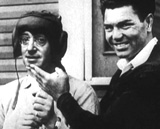
With Boxer Jack Dempsey
|
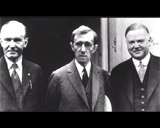
With Coolidge and Herbert Hoover
|
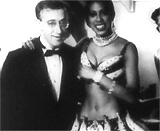
With Josephine Baker
|
- meanwhile, as Zelig had become "devoid of personality,"
Dr. Fletcher began to abandon her hope of helping Zelig to recover;
Zelig's life was turned upside down when a deadly 'love triangle'
resulted in the murders of Zelig's guardians Ruth Zelig and Martin
Geist - and Zelig went missing (either he was lost or hiding)
at the end of the 1920's; Dr. Fletcher regained custody of his
psychotherapeutic treatment to be conducted in her country home,
and recorded by photographer Paul Deghuee (John Rothman) in a
series known as "The White Room Sessions"
- Dr. Bruno Bettelheim (as Himself) (in a color insert
segment) spoke about Zelig's condition: "The question whether
Zelig was a psychotic or merely extremely neurotic was a question
that was endlessly discussed among us doctors. Now I myself felt
that his feelings were really not all that different from the normal,
maybe what one would call the well-adjusted normal person only
carried to an extreme degree, to an extreme extent. I myself felt
that one could really think of him as the ultimate conformist"
- during the "White Room Sessions," Leonard
insisted he was the doctor (calling himself Dr. Zelig), causing
Dr. Fletcher immense frustration; however, in a "breakthrough" strategy,
she decided to reverse roles with him; she pretended he was now
the doctor and asked for advice on how to deal with his problem:
("I want so badly to be liked, to be like other people so
I don't stand out") - Zelig suffered a severe
"identity disorder" when he admitted to her: "No,
I'm nobody. I'm nothing"
- as time went on over a three month period, Dr. Fletcher
realized that she was falling in love with Zelig: ("And then
I found I had very strong feelings for him"); his treatment
was going well, but only under hypnosis were there signs of improvement;
but then Dr. Fletcher feared that her cure to have him voice his
own opinions had gone too far: (Narrator: "He has been molded
too far in the other direction. He has become over-opinionated
and cannot brook any disagreement with his own views"); Dr.
Fletcher admitted: "I'd taken him too far in the other direction" -
he had become intolerant
- after being "cured," Leonard and Dr. Fletcher
became a couple ("fast friends") and were the town's
newest celebrities - it was a major "success story" for
the psychiatrist; Eudora and Leonard were invited to San Simeon
in California, to meet tycoon publisher William Randolph Hearst,
his mistress/actress Marion Davies, and other stars such as Charles
Chaplin and Marie Dressler; Leonard met western actor Tom Mix and
other stars, including golfer Bobby Jones
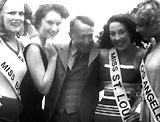
Leonard With Bathing Beauties
|
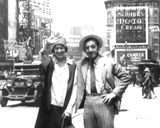
In Downtown NYC
|
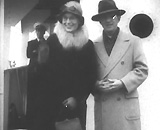
On a Cruise Ship
|
|
Leonard and Dr. Fletcher - Famous and Popular
In the 1930s
|
- Leonard soon became famous, and was on a speakers'
circuit, proclaiming he was no longer "a member of the reptile
family"
-- "You got to be yourself. You know you can’t act like
anybody else just because you think that they have all the answers
and you don't. You have to be your own man, and learn to speak up
and say what's on your mind"; the Narrator
summarized that Zelig was no longer a chameleon: "He is finally
an individual, a human being. He no longer gives up his own identity
to be a safe and invisible part of his surroundings"
- essayist Susan Sontag (as Herself) congratulated
Dr. Fletcher for her success with Zelig -- "a remarkable creative
accomplishment"
- inevitably, fame and their announcement of a spring
marriage brought forth his downfall: "the roof fell in" --
numerous women claimed that Leonard was already married and had
fathered children -- Zelig was shaken by the scandals, and admitted
that he might have committed the accusations during one of his "spells" or
changes in personality; his destructive fall from grace was immediate
and marked by "dozens of lawsuits"; he was branded as
a "criminal" (Narrator:
"He is sued for bigamy, adultery, automobile accidents, plagiarism,
household damages, negligence, property damages and performing unnecessary
dental extractions"); Zelig's emotional condition deteriorated "under
the weight of conservative moral opinion"
- when Leonard's illness returned ("He longs
desperately to be liked once again to be accepted, to fit in"),
and he faced charges of polygamy and fraud, he vanished by fleeing
the country, although there were various false sightings
- eventually, Zelig was located
in Berlin, Germany, presumably working with the Nazis before WWII;
he was pictured with the Fascist Fuhrer Adolf Hitler himself; Dr.
Fletcher sailed to Europe and after four weeks of searching, found
him at a huge Nazi rally in Munich seated behind Hitler, and they
were able to escape from the SS after disrupting the event
- they flew back to America (Zelig transformed into
a pilot and flew their plane non-stop and upside down to the US
in record time), where they were now proclaimed heroes in a NYC
ticker tape parade; Zelig was awarded the Medal of Valor by Carter
Dean (Bernie Herold); Zelig admitted that his total psychosis could
lead to amazing accomplishments ("it shows exactly what you
can do if you're a total psychotic"); Saul Bellow noted: "It
was his very disorder that made a hero of him"; they were
soon married and "lived full and happy years together"
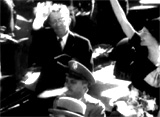
Ticker-Tape Parade in NYC
|

The Medal of Valor
|
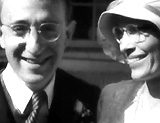
Happily Married
|
|

In the Next-at-Bat Circle with Babe Ruth
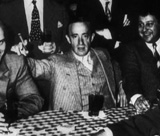
As Gangster in Speakeasy
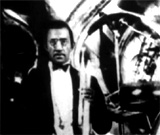
As Colored Trumpeter
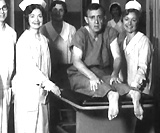
Zelig Subjected to Physical and Psychological Tests by Doctors
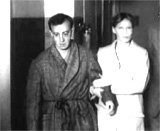
Treated and Studied by Dr. Eudora Fletcher (Mia Farrow)
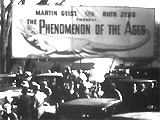
Zelig as a "Human Chameleon" Tourist Attraction
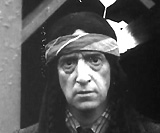
Zelig as a Native-American
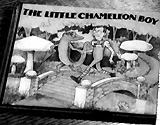
Books ("The Little Chameleon Boy") and Zelig-Related Toys
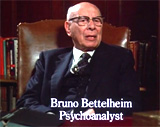
Bruno Bettelheim - Psychoanalyst
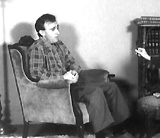
White Room Sessions: Leonard Insisted He Was the Doctor
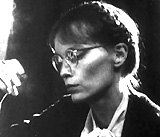
Dr. Fletcher's Frustration with Zelig
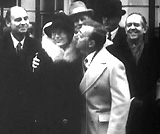
Dr. Fletcher and Zelig Falling in Love
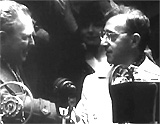
Leonard Presented With Key to NYC
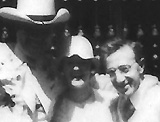
Zelig at San Simeon with western actor Tom Mix
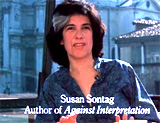
Susan Sontag - Commentary on Zelig

Zelig Scandal
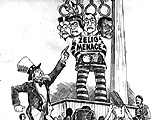
"Zelig Menace" - The Return of His Condition
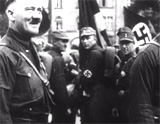
Zelig in Adolf Hitler's Presence in Berlin, Germany
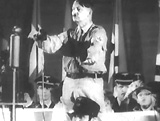
Zelig Behind Hitler at Munich Nazi Rally
|




















